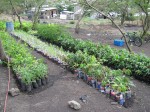Having worked with CdA in the U.S. for two years now, I cannot express how exciting overwhelming it has been to finally visit our community in Jinotega.
One of the most special aspects of my trip is watching Nancy meet and interact with her student, 8-year-old Geovania, for the first time. A shy, inquisitive girl, Geovania has an adorable smile. Attached at the hip to her 4-year-old sister, Judith, and 11-year-old cousin, Karla, Geovania was glad to share her experiences with her family. Nancy would come to use the phrase “my girls” to describe them and truly understand that her monthly sponsorship funds don’t simply secure the education for just one girl, but that of three.
Nancy received an invitation to visit Geovania’s home, one she gladly accepted. I towed along for the experience. A steep, steep muddy hill greeted us. I cannot image how children run up and down this numerous times a day, let alone when it’s wet. Keep in mind, we’re in Jinotega during the dry season. In the tropics, there are times of the year when the rain pours from the skies for days on end. Last year, it rained for 10 days straight at one point. People in the surrounding areas died.
Geovania and family were waiting for us. One of the nicer homes in the barrio, they have cylinder block walls that create a small livingroom and two bedrooms. They have an attached washroom, which is three things combined: toilet, shower, and laundry room. Like 99% of neighborhood, clothes are washed against a concrete slab, the same place the drinking water comes from. The kitchen, such as it is, is a small stove-top rigged outside of the front door, under a corrugated metal awning.
Geovania lives with at least 4 other people in a space smaller than the room I rent in the States. She does not have a refrigerator. She does not have a plethora of toys to play with, nor does she have a closet full of clothes. Her diet is limited to rice and beans, and she may eat meat and veggies a few times a month. For everything Geovania does not have, I cannot help but be astounded — the girl lives with a smile on her face and she never asked us for anything.
We could all learn something from this little girl.















































